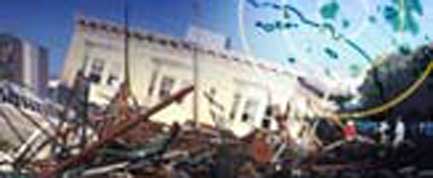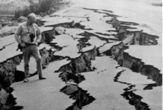New Earthquake Warnings: Enough Time to Dive Under a Desk

The magnitude of an earthquake can be roughly predicted as the shaking begins, according to new research that promises to provide several seconds of warning before the brunt of a catastrophe strikes.
Earthquake prediction has proved tricky. Scientists can't pinpoint the timing of a rupture to within days or even months or years. But the new method provides an accurate glimpse of what will happen in just a moment.
"We can determine the magnitude within a couple of seconds of initiation of rupture and predict the ground motion from seconds to tens of seconds before it's felt," says Richard Allen, a seismologist at the University of California, Berkeley.
If an automatic warning system were set up, there might be time for school children to dive under desks and others to hunker down in doorways, Allen figures.
Waves come in waves
The prediction is made possible by the fact that a typical earthquake sends out three different types of waves, which Allen has been studying for the past few years. He and colleague Erik Olson of the University of Wisconsin-Madison examined the seismic records of 71 large temblors.
- Primary waves, or P waves, come first. They move like a pressure wave, typically creating a jolt. P waves are the least destructive.
- Next comes a secondary wave, or S wave. It shears the ground back and forth and up and down.
- Then come surface waves, the most destructive. They jerk the ground sideways and later roll in like ocean waves.
The frequency of P waves is related to the intensity of the eventual surface waves, Allen and his colleagues have determined.
Sign up for the Live Science daily newsletter now
Get the world’s most fascinating discoveries delivered straight to your inbox.
The idea flies in the face of convention, which holds that a quake's outcome depends on a cascade of unpredictable events along a fault that occur after an initial eruption.
The new results "imply that the final magnitude of an earthquake depends at least partially on what happens in its first few seconds," says Rachel Abercrombie, an expert in earthquake rupture at Boston University who was not involved in the study.
While no two earthquakes are alike, San Francisco would likely get 20 seconds or more of warning for a major temblor, Allen said.
"It is not a perfect system," Allen told LiveScience. But he added that all of the large-magnitude earthquakes his team has studied "do show this characteristic of the first few seconds" that allow a useful prediction. "The magnitude estimates in the study are within plus and minus 1 magnitude unit. For some events the error will be greater than others."
The science behind the idea is detailed in the Nov. 10 issue of the journal Nature.
Getting the word out
Another key to the prediction system is that not everyone sits atop the spot where an earthquake originates, and the waves of an earthquake travel much more slowly than the light-speed communications that could send a warning.
If a rupture occurs at the extreme northern end of the 800-mile San Andreas fault, for example, the shaking could take 80 seconds, traveling about 2 miles per second, to reach San Francisco. Such a far-off event might not destroy the City by the Bay. But no matter where the epicenter, there would be a window for warning most of the ultimate victims.
"It is more likely than not that there would be greater than 20 seconds warning for the earthquakes most damaging to the city of San Francisco," Allen's team states on its web site.
Allen said at least a year of further testing is needed before a real warning system could go live.
He envisions using the Internet to transmit information of a quake. A computer at the other end would interpret the warning for the specific location and estimate timing and intensity of the anticipated shaking. There might be multiple warning methods.
"Cell phone towers could determine the impact of the earthquake for the area they cover and transmit a warning to the cell phones within range," Allen said.
Allen is working with the U.S. Geological Survey to determine how accurate the warnings from his Earthquake Alarm Systems (ElarmS) would be.
Image Gallery

Robert is an independent health and science journalist and writer based in Phoenix, Arizona. He is a former editor-in-chief of Live Science with over 20 years of experience as a reporter and editor. He has worked on websites such as Space.com and Tom's Guide, and is a contributor on Medium, covering how we age and how to optimize the mind and body through time. He has a journalism degree from Humboldt State University in California.










